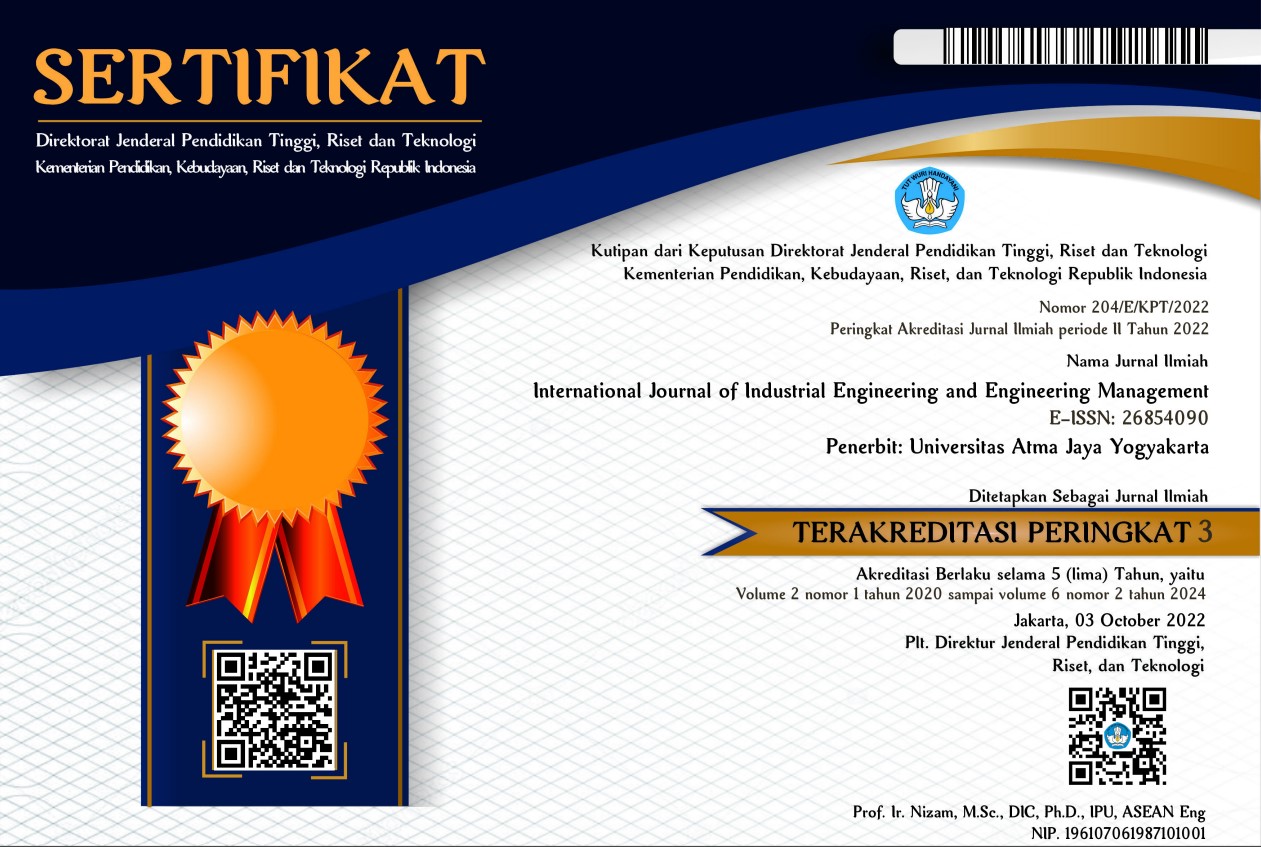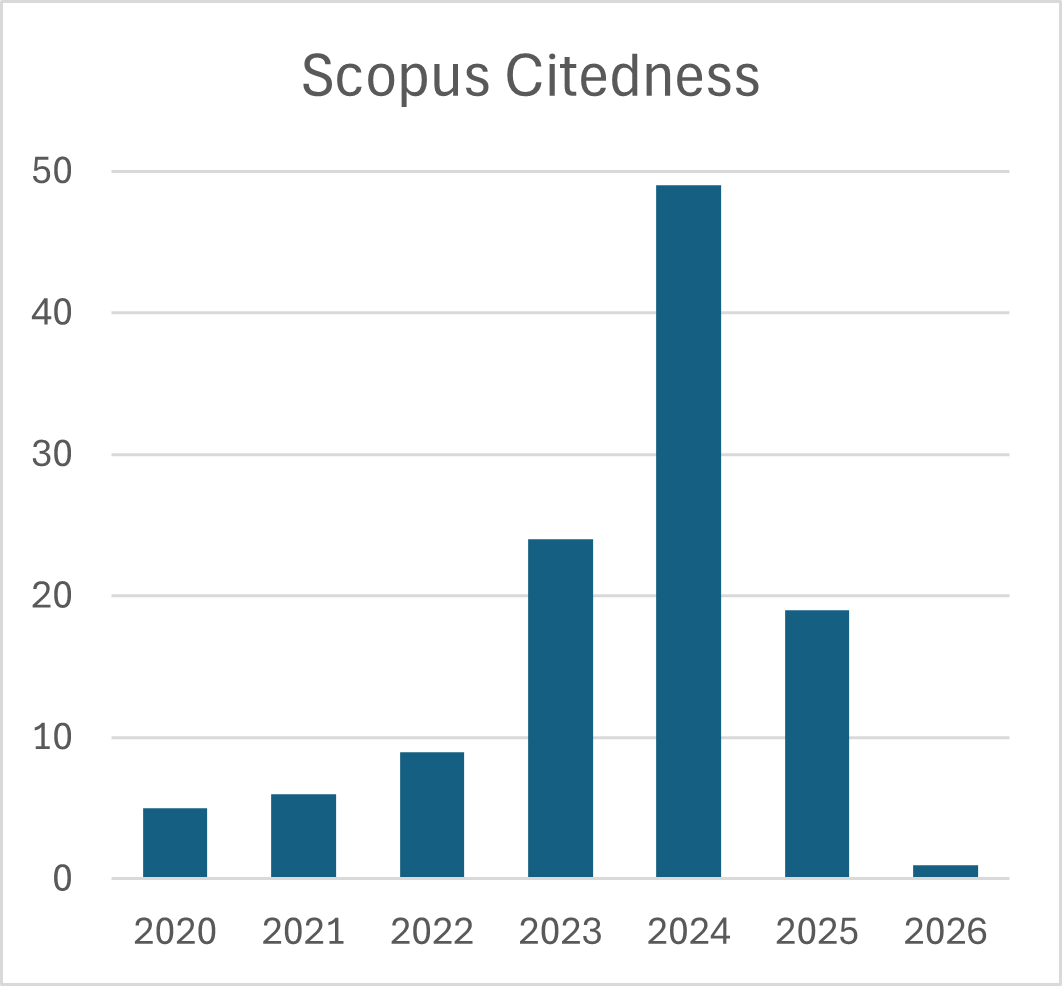An Application of Data Envelopment Analysis in the Selection of the Best Response for the Drilling of Carbon Fiber-reinforced Plastic Composites
DOI:
https://doi.org/10.24002/ijieem.v5i1.5792Keywords:
data envelopment analysis, CFRP composite, defect reduction, efficiency, drilling operationAbstract
In the drilling operation, defects such as delamination at exit and entry are very disturbing responses that impact the efficiency of the drilling process. Without control, an exponential growth in the amount of drilled components with defect quantities may result. Thus, the process engineer has input in attaining the desired production levels for components in the drilling process. Consequently, this article deploys a novel method of data envelopment analysis to evaluate the relative efficiency of the drilling process in reducing the defects possible in the producing components from the CFRP composites. The high-speed steel drill bits were utilized to process the CFPs, while the responses considered are the entry and exit determination, thrust force, and torque, among others. Literature experimental data in twenty-seven experimental counts were summarized into fewer groups and processed through the data envelopment analysis method. The results show that capturing the CFRP composite responses is feasible, providing an opportunity for enhanced efficiency and a situation where undesirable defects in the CFRP composite production process may be eradicated. The article’s uniqueness and primary value are in being the foremost article in offering an updated vast representation of the comparative efficiency of CFRP composite parameters within the literature for the composite area. The work adds value to the CFRP composite literature by envisaging and understanding the comparative efficiency for the parameters, identifying and separating the best from the worst decision-making unit. It also reveals how the parameters are linked by their relative placements. The article's novelty is that using data envelopment to compare the efficiency in reducing drilling defects such as entry and exit determination, among others. The method’s utility is to provide information for cost-effective drilling operations during the planning and control phases of the operation.
References
Abiola, I.T., & Oke, S.A. (2021). Performance evaluation of surface roughness in the boring operation of IS 2062 E250 plate on CNC machine using combined entropy-decision tree-VIKOR approach. International Journal of Industrial Engineering and Management, 2(1), 1–15.
Abiola, I.T., & Oke, S.A. (2022). Fuzzy analytic hierarchy process and Markov-chain -WSM/WPM/WASPAS approach to solving the surface roughness problem in the boring of IS 2062 E250 steel plates on CNC machines. International Journal of Industrial Engineering and Management, 3(1), 47-71.
Adeniran, M.K., & Oke, S.A. (2022). Surface integrity analysis of wire electric discharge machining of nitinol shape memory alloy: A literature review. International Journal of Industrial Engineering & Management, 3(2), 85-94.
Aggarwal I., Gunreddy N., & Rajan, A.J. (2021). A hybrid suppheir selection approach using machine learning and data envelopment analysis, IEEE 2021 Innovations in Power and Advanced Computing Technologies, Kuala Lumpur, Malaysia, 27-29 November.
Alabi, B., Salau, T.A.O., & Oke S.A. (2007). Surface finish quality characterization of machined workpieces using fractal analysis. Mechanica, 64(2), 65-71.
Balak, S., Behzadi, M.H., & Nazari, A. (2021). Stochastic copula DEA model based on the dependence structure of stochastic variable: An application to twenty bank branches. Economic Analysis and Policy, 72, 326-341.
Brinksmeier, E., & Janssen, R. (2002). Drilling of multi-layer composite materials consisting of carbon fiber reinforced plastics (CFRP), titanium, and aluminum alloys. CIRP Annals, 51(1), 87-90.
Chen, X., Liu, X., Gong, Z., & Xie, J. (2021a). Three-stage super-efficiency DEA models based on the cooperative game and its application on the R and D green innovation of Chinese high-tech industry. Computers and Industrial Engineering, 156, Article 107234.
Chen, K., Ren, X.T., & Yang, G.L. (2021b). A novel approach for assessing academic journals: Application of integer DEA model for management science and operations research field. Journal of Informatics, 15(3), Article 101176.
Ebrahimi, B., & Hajizadeh, E. (2021). A novel DEA model for solving performance measurement problems with flexible measures: An application to Tehrah stock exchange. Measurement, 179, Article 109444.
Goto, M., & Sueyoshi, T. (2022). Sustainable development and convergence under energy sector transition in industrial ratios: An application of DEA environmental assessment. Socio-Economic Planning Science, available online, Article 101316.
Ghiyasi, M., Soltanfar, M., & Sharafi, H. (2022). A novel inverse DEA-R model with application in hospital efficiency. Socio-Economic Planning Science, available online, Article 1014227.
Harigai, T., Degai, S., Sugie, Y., Takikawa, H., Tanimoto, T., Gonda, H., Kaneko, S., Kunitsugu, S., Suzuki, K., Kamiya, M., & Taki, M. (2021). Improvement of drilling performance by overcoating diamond-like carbon films on diamond-coated drills for carbon fiber-reinforced plastics processing. Vacuum, 183, Article 109755.
Hernandez, D.A., Soufen, C.A., & Orlandi, M.O. (2017). Carbon fiber reinforced polymer and epoxy adhesive tensile test failure analysis using scanning electron microscopy. Materials Research, 20.
Ighravwe D.E., & Oke S.A. (2015). The application of artificial neural network and fuzzy inference system for machining process with respect to material removal rate and surface roughness. The Kenya Journal of Mechanical Engineering, 8(1), 9–23.
Ighravwe, D.E., & Oke, S.A. (2022). Surface roughness prediction and optimization for CNC end milling machining process using novel joint artificial neural network and bat algorithm methods. International Journal of Integrated Engineering, 14(4), 20–34.
Karnik, S., Gaitonde, V., Rubio, J.C., Correia, A.E., Abrão, A., & Davim, J.P. (2008). Delamination analysis in high-speed drilling of carbon fiber reinforced plastics (CFRP) using artificial neural network model. Materials & Design, 29(9), 1768-1776.
Khodadadipour, M., Hadi-Vencheh, A., Behzadi, M.H., & Rostamy-Malkhalifeh, M. (2021). Undesirable factors in stochastic DEA cross-efficiency evaluation: An application to thermal power plant energy efficiency. Economic Analysis and Policy, 69, 613–628.
Krishnamoorthy, A., (2011). Some studies on modeling and optimization in drilling carbon fiber reinforced plastic composites, Ph.D. Thesis, Faculty of Mechanical Engineering, Anna University, Chennai, India.
Lin, Y.H., Karin, P., Larpsuriyakul, P., & Ohtake, N. (2022). Physicomechanical characteristics of carbon fiber reinforced polymer composite using x-ray diffraction, atomic force, and electron microscopies. International Journal of Automotive Technology, 23, 1349–1363.
Liu, Y., Zou, A., Wang, G., Han, C., & Blackie, E. (2022). Enhancing interlaminar fracture toughness of CFRP laminates with hybrid carbon nanotube/graphene oxide fillers. Diamond and Related Materials, 128, Article 109285.
Liu, J.S., Lu, L.Y.Y., Lu, W.M.L: in B.Y.N. (2013). A survey of DEA applications. Omega, 41, 893 -902.
Li, Y. (2020). Analysis efficiencies of city commercial banks in China: an application of the bootstrapped DEA approach pacific-basin. Finance Journal, 62, Article 101372.
Luo, L., Chen, H., Yang, Y., Wu, G., & Chen, L. (2022). A three-stage network DEA approach for performance evaluation of BIM application in construction projects. Technology in Society, 71, Article 102105.
Makhdum, F., Norddin, D.N., Roy, A., & Silberschmidt, V.V. (2012). Ultrasonically assisted drilling of carbon fiber-reinforced plastics. Solid State Phenomena, 188, 170-175.
Mariani, M.M., & Visani, F. (2019). Embedding eWOM into efficiency DEA modeling: An application to the hospitality sector. International Journal of Hospitality Management, 80, 1–12.
Melo, I.C., Junior, P.N.A., Pera, T.G., Caixeta-filho, J.V., & Rebelatto, D.A. (2020). Framework for logistics performance index construction using DEA: An application for soybean haulage in Brazil. Transportation Research Procedia, 48, 3090–3106.
Mura, M.D., & Dini, G. (2021). Drilling carbon fiber reinforced plastics with pre-cooling treatment by cryogenic fluid. Journal of Manufacturing Processes, 68, 23-31.
Nedaei, H., Naini, S.G.J., & Makwi, A. (2020). A dynamic DEA models to measure the learning rates of efficiency frontier and DMUs: An application to oil and gas wells drilling. Computers and Industrial Engineering, 144, Article 106434.
Ning, N., Wang, M., Zhou, G., Qiu, Y., & Wei, Y. (2022). Effect of polymer nanoparticle morphology on fracture toughness enhancement of carbon fiber reinforced epoxy composites. Composites Part B: Engineering, 234, Article 109749.
Nong, N.M.T. (2022). An application of Delphi and DEA to performance efficiency assessment in retail stores in fashion industry. The Asian Journal of Shipping and Logistics, 38(3), 135–145.
Odusoro, S.I., & Oke, S.A. (2021a). Factor selection in drilling unidirectional carbon fiber reinforced plastic composite plates with the HSS drill bit using analytic hierarchy process. International Journal of Industrial Engineering and Engineering Management, 3(1), 1–15.
Odusoro, S.I., & Oke, S.A. (2021b). A fuzzy analytic hierarchical method to reduce imprecision and uncertainty in drilling operation’s factor selection process for unidirectional carbon fiber reinforced plastic composite plates. International Journal of Industrial Engineering and Engineering Management, 3(1), 17–26.
Odusoro, S.I., & Oke, S.A. (2021c). An application of the PROMETHEE method to select the best response for carbon fiber reinforced plastic drilling in machining operations. International Journal of Industrial Engineering and Engineering Management, 3(2), 77–90.
Omrani, H., Alizadeh, A., Emrouznejad, A., & Teplova, T. (2022). A robust credibility DEA model with fuzzy perturbation degree: An application to hospitals performance. Expert Systems with Applications, 189, Article 116021.
Pranesh, R.V., Rajan, A.J., & Navas, K.B. (2013). Evaluating the performance of state university, national important institute and private deemed universities in chemical (India) by using data envelopment analysis. Proceedings of the World Congress on Engineering, 1, 1-6.
Peykani, P., Mohammad, E., & Emrouznejad, A. (2021). An adjustable fuzzy chance-constrained network DEA approach with application to ranking investment firms. Expert Systems with Applications, 166, Article 113938.
Rodrigues, L.S., dos Santis, M., & de Sonzaro Chajumor, C. (2022). Application of DEA and group analysis using K-means: Compliance in the context of the performance evaluation of school networks. Procedia Computer Science, 199, 687-696.
Seo, J., Banerjee, N., Kim, Y., Kim, D. C., & Park, H.W. (2020). Experimental and analytical investigation of the drilling forces of the carbon fiber reinforced plastics including thermal effects. Journal of Manufacturing Processes, 58, 1126–1137.
Shi, Y., Wang, X., Wang, F., Gu, T., Xie, P., & Jia, Y. (2020). Effects of inkjet printed toughener on delamination suppression in drilling of carbon fiber reinforced plastics (CFRPs). Composite Structures, 245, Article 112339.
Sridhar, A. K., Bolar, G., & Padmaraj, N. (2021). Comprehensive experimental investigation on drilling multi-material carbon fiber reinforced aluminum laminates. Journal of King Saud University - Engineering Sciences, In press.
Song, W., Chen, Y., Mu, Z., Wang, Y., Zhang, Z., Wang, Z., Liu, L., Zhang, B., Li, Y., Li, B., Zhang, D., Zhang, J., Niu, S., Han, Z., & Ren, L. (2022). A feather-inspired interleaf for enhanced interlaminar fracture toughness of carbon fiber-reinforced polymer composites. Composites Part B: Engineering, 236, Article 109827.
Suzuki, K., Koyasu, R., Takeda, Y., & Sasahara, H. (2019). Application of a novel woven metal wire tool with electrodeposited diamond grains for carbon fiber reinforced plastics core drilling. Precision Engineering, 56, 386-394.
Voss, R., Henerichs, M., & Kuster, F. (2016). Comparison of conventional drilling and orbital drilling in machining carbon fiber reinforced plastics (CFRP). CIRP Annals, 65(1), 137-140.
Wegener, M., & Amin, G.R. (2019). Minimizing greenhouse gas emissions using inverse DEA with an application in oil and gas. Expert Systems with Applications, 122, 369-375.
Yao, Y., Shi, P., Chen, M., Chen, G., Gao, C., Boisse, P., & Zhu, Y. (2022). Experimental and numerical study on Mode I and Mode II interfacial fracture toughness of co-cured steel-CFRP hybrid composites. International Journal of Adhesion and Adhesives, 112, January 2022, 103030.
Yesilyurt, M.E., Sahin, E., Elbi, M.D., Kizikaya, A., Koyuncuoghu, M.U., & Yesiyurt, F.A. (2021). A novel method for computing single output of DEA with application in hospital efficiency. Socio-Economic Planning Science, 76, Article 100995.
Zhou, Z., Xu, G., Wang, C., & Wu, J. (2019). Modeling unmeasurable output with a DEA approach based on an exponential transformation: an application to measure the energy efficiency of Chinese industry. Journal of Cleaner Production, 236, Article 117717.
Downloads
Published
How to Cite
Issue
Section
License
Copyright (c) 2023 Wasiu Oyediran Adedeji, Salome Ifeoluwa Odusoro, Kasali Aderinmoye Adedeji, John Rajan, Sunday Ayoola Oke, Elkanah Olaosebikan Oyetunji, Ugochukwu Sixtus Nwankiti

This work is licensed under a Creative Commons Attribution 4.0 International License.








